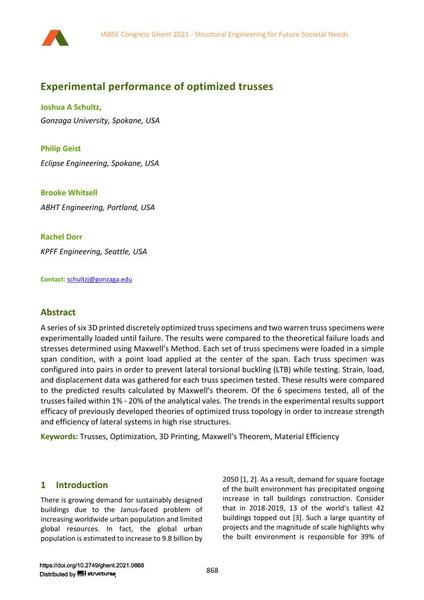Experimental performance of optimized trusses

|
|
|||||||||||
Détails bibliographiques
| Auteur(s): |
Joshua A. Schultz
(Gonzaga University, Spokane, USA)
Phillip Geist (Eclipse Engineering, Spokane, USA) Brooke Whitsell (ABHT Engineering, Portland, USA) Rachel Dorr (KPFF Engineering, Seattle, USA) |
||||
|---|---|---|---|---|---|
| Médium: | papier de conférence | ||||
| Langue(s): | anglais | ||||
| Conférence: | IABSE Congress: Structural Engineering for Future Societal Needs, Ghent, Belgium, 22-24 September 2021 | ||||
| Publié dans: | IABSE Congress Ghent 2021 | ||||
|
|||||
| Page(s): | 868-876 | ||||
| Nombre total de pages (du PDF): | 9 | ||||
| DOI: | 10.2749/ghent.2021.0868 | ||||
| Abstrait: |
A series of six 3D printed discretely optimized truss specimens and two warren truss specimens were experimentally loaded until failure. The results were compared to the theoretical failure loads and stresses determined using Maxwell’s Method. Each set of truss specimens were loaded in a simple span condition, with a point load applied at the center of the span. Each truss specimen was configured into pairs in order to prevent lateral torsional buckling (LTB) while testing. Strain, load, and displacement data was gathered for each truss specimen tested. These results were compared to the predicted results calculated by Maxwell’s theorem. Of the 6 specimens tested, all of the trusses failed within 1% - 20% of the analytical vales. The trends in the experimental results support efficacy of previously developed theories of optimized truss topology in order to increase strength and efficiency of lateral systems in high rise structures. |
||||
| Copyright: | © 2021 International Association for Bridge and Structural Engineering (IABSE) | ||||
| License: | Cette oeuvre ne peut être utilisée sans la permission de l'auteur ou détenteur des droits. |
||||
